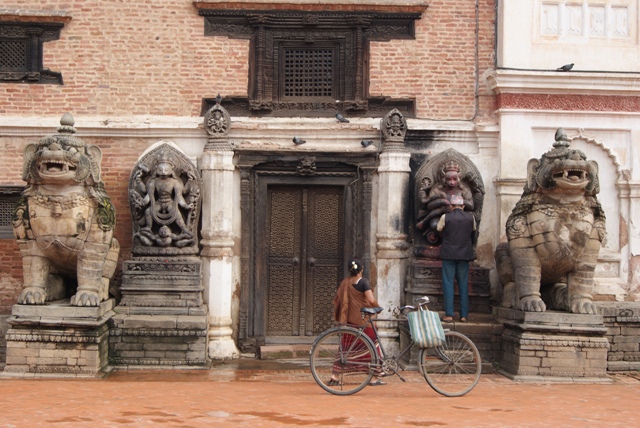The following travelogue on Nepal is based on the series ‘See More Nepal’ written and directed by me for Travel Trendz TV.
Were there nothing else in Nepal save the Bhaktapur Durbar Square, it would still be aptly worth making a journey half way round the globe to see. E.A. Powell, The Last Home of Mystery, 1929, London
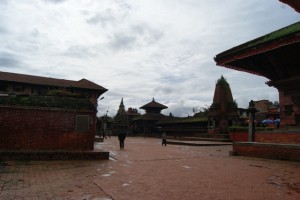 Bhaktapur, between the 14th and the 16th centuries, was the capital of Nepal. Though today it has lost the privilege to Kathmandu, it still retains its culture and traditions, some say, even better than Kathmandu or Patan. One reason is that it is 15kms away from the madding crowd, the choking traffic and the general mayhem of the capital city. During the ancient days, the city was an important business centre as it was located in the bustling trade route to Tibet. The inhabitants were prosperous and self reliant. They were blessed with a fertile soil and the farmers could make enough produce to feed the entire town. The craftsmen were a respected lot and they were entrusted with the task of making the temples really fit for the gods. And by the looks of it, they did extraordinary justice to their responsibilities.
Bhaktapur, between the 14th and the 16th centuries, was the capital of Nepal. Though today it has lost the privilege to Kathmandu, it still retains its culture and traditions, some say, even better than Kathmandu or Patan. One reason is that it is 15kms away from the madding crowd, the choking traffic and the general mayhem of the capital city. During the ancient days, the city was an important business centre as it was located in the bustling trade route to Tibet. The inhabitants were prosperous and self reliant. They were blessed with a fertile soil and the farmers could make enough produce to feed the entire town. The craftsmen were a respected lot and they were entrusted with the task of making the temples really fit for the gods. And by the looks of it, they did extraordinary justice to their responsibilities.
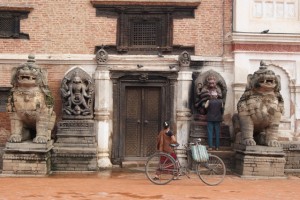
A living heritage
‘Bhaktapur’ meaning ‘city of devotees’ proudly bears the title of the ‘cultural capital of Nepal’ and lives up to it. Listed as a World Heritage by UNESCO for its exquisite temples, exotic wood carvings and other rococo works in stone and metal, Bhaktapur is in a class of its own. Compared to the other durbar squares, the Bhaktapur Durbar Square is quite spacious. Ironically, this is because of an earthquake that happened in 1934 which destroyed many of the temples and monuments that stood here once. This is a living heritage in every sense. There is even a school inside the premise, the entrance to which is the famous lion gate. Right next to the lions that stand as a possible deterrent for students bunking classes, is the statue of Ugrachandi, one of the masterpieces in stone. Ugrachandi is the fearful manifestation of the consort of Lord Shiva. Bhairab, the fierce avatar of Lord Shiva, associated with annihilation, is revered all over Nepal by both Hindus as well as Buddhists. Bhairab is invoked to destroy and annihilate enemies. The images of Bhairab which you find in the durbar square hence are quite ferocious and intimidating.
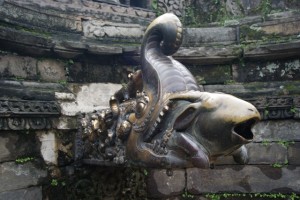
The golden spout in the pool
The Dattatreya Square named after the triad deities, Brahma the creator, Vishnu the preserver and Maheshwara the emancipator are a delight for those interested in wood carvings. The Square also features some of the finest examples of metal craftsmanship you would ever see. The 55 Windows Palace, built in the 18th century, is made of brick and has an upper floor entirely of wooden windows. Hence, the name. The earthquake of 1934 partially destroyed the palace. Fortunately some of the more exotic carvings were mercifully spared from the fury. The Taleju Bhawani was the preferred deity for the kings here as well. Getting inside the Taleju temple complex is not usually encouraged but you can persuade the armed guards to look the other way. Once inside the complex, you get a foretaste of some imperial preferences. The Mallas, it seems, were as fond of luxuries as they were of their gods. Their swimming pool had an open terrace for sunbathing. The golden spout was for filling the pool with water and the entire pool was outlined like a sprawled snake. Even inside the pool, the kings had set up miniature temples – well, it definitely looked like they had long-lasting bathing sessions.
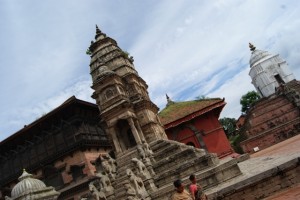
A view of the Lohan Dega
At the southeastern corner of the royal palace is the Siddhi Lakshmi Temple. This is known as the ‘Lohan Dega’ or the stone temple. The steps leading up to the temple is flanked by the male and female species of animals and two nobles at the bottom, each of them are shown dragging a naked child and a dog. Just five minutes from the Durbar Square is the Taumadhi Square where the legendary Nyatapola temple stands towering elegantly. ‘Nyata’ is Nepali means ‘five stepped’. The Nyatapola, rising to a regal 30 metres, is Nepal’s tallest temple. Balanced on five receding square plinths, there are five balconies over which are five roofs each supported by magnificently carved wooden columns. At the bottom of the steep stairway that leads up to the temple are two wrestlers from the Malla times who were famed for their skill and strength. Further upwards are lions and griffins and statues of goddesses Singhini and Baghini.
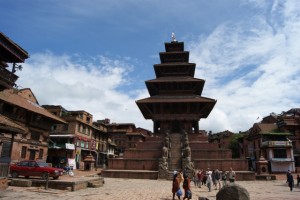
The Nyatapola
The temple was built by King Bhupatindra Malla for his favourite deity the Siddhi Lakshmi. There are 108 wooden beams that support the roof from below, each depicting the goddess in her different forms. However, one strange fact is that despite the size and the allure of the temple, no one has really seen the goddess. The temple offers great views of the durbar square as well as the surrounding areas. The brick red of the square offers a fabulous contrast against the verdant green of the mountain of the valley. Set at right angles to the Nyatapola is the Bhairavnath Mandir. The three-tiered roof which stands against a clear afternoon sun shows off a massive grandeur. The temple, dedicated to the city’s patron god Bhairav is believed to have extraordinary powers which make it a favourite among the locals.
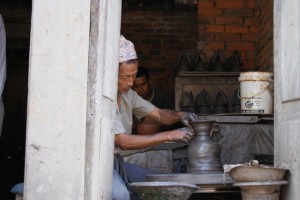
Friendly potter wheels
Southwest from the Nyatapola square is the famous pottery market. If you do enjoy the high that you get by moulding a mound of clay into beautiful objects, or just enjoy seeing the finished goodies, then this is a place you cannot afford to miss. Here, the amiable and ever helpful craftsmen take novices through the basic motions. Alleys where culture oozes out from every corner. Heritage buildings standing tall, bearing testimonial to an era that earned it the label of the ‘culture capital’. Exotic works by immensely gifted and talented craftsmen. A charming people. If you have to make a trip half way around the globe to see Bhaktapur, I second Mr Powell that you make it.
 Bhaktapur, between the 14th and the 16th centuries, was the capital of Nepal. Though today it has lost the privilege to Kathmandu, it still retains its culture and traditions, some say, even better than Kathmandu or Patan. One reason is that it is 15kms away from the madding crowd, the choking traffic and the general mayhem of the capital city. During the ancient days, the city was an important business centre as it was located in the bustling trade route to Tibet. The inhabitants were prosperous and self reliant. They were blessed with a fertile soil and the farmers could make enough produce to feed the entire town. The craftsmen were a respected lot and they were entrusted with the task of making the temples really fit for the gods. And by the looks of it, they did extraordinary justice to their responsibilities.
Bhaktapur, between the 14th and the 16th centuries, was the capital of Nepal. Though today it has lost the privilege to Kathmandu, it still retains its culture and traditions, some say, even better than Kathmandu or Patan. One reason is that it is 15kms away from the madding crowd, the choking traffic and the general mayhem of the capital city. During the ancient days, the city was an important business centre as it was located in the bustling trade route to Tibet. The inhabitants were prosperous and self reliant. They were blessed with a fertile soil and the farmers could make enough produce to feed the entire town. The craftsmen were a respected lot and they were entrusted with the task of making the temples really fit for the gods. And by the looks of it, they did extraordinary justice to their responsibilities. 

